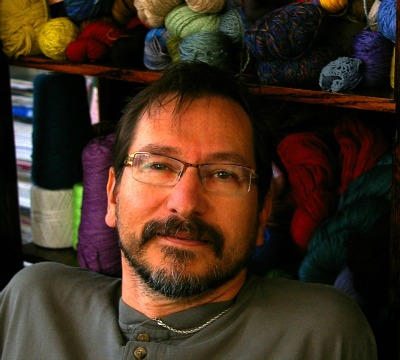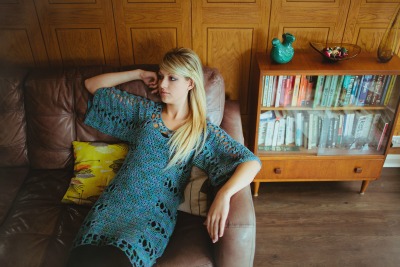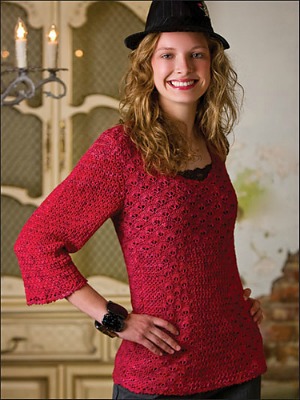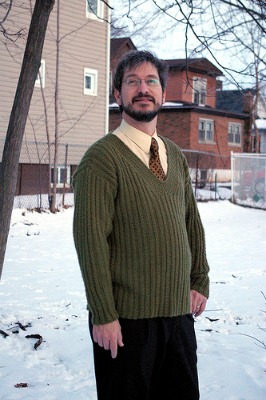This post is part of my 2012 Hispanic Heritage Month interview series.
I’m really excited to interview Charles Voth, also known as Stitch Stud, today. Charles is a crochet and knitting designer and tech editor. (If you’re not sure what a tech editor is, you may want to check out this interview with Juanita Quinones. And if you get really excited about tech editing, you may want to sign up for these upcoming tech editing classes Charles is teaching at online at Crochet Insider.) Charles is an active participant in several online forums for crochet designers, and over the years I’ve seen him generously sharing his knowledge with more junior designers (including me!). In the past year, I’ve had the great pleasure of getting to (virtually) meet Charles when he tech edited one of my patterns. You can find Charles online at his website, Charles Voth Designs, on Ravelry (as StitchStud and on his designer page), and on Twitter. All photos are used with permission.

Underground Crafter (UC): How did you learn to crochet and knit?
Charles: When I was 5, a woman visiting my mother was crocheting a blue hat. I was fascinated with the movement of her hands and that a 3-d object was appearing from a piece of yarn. I asked her to teach me. She taught me to finger chain that day, and came back another time to teach me how to use a hook. What I made after with the basic stitches I learned, I can’t recall. I remember making a doily in thread following a pattern when I was 8 or 9. I had no-one to help me crack the code of pattern text and abbreviations, but somehow with the photo and the index of stitches I figured it out. When I was 10 or 11, I saw some Guambiano tribesmen knitting and spinning with drop-spindles (in Popayan, Colombia) and I asked my dad what they were doing. He explained what it was and I asked him if I could learn to knit. Fortunately, my grade 5 teacher was a knitter and my dad asked her to teach me. He bought me my first yarn and needles. I am a “thrower”, and faster at it than at “picking”, but when my Russian-born grandmother saw me throwing upon my visit with her in Canada, she was dismayed, and tried to get me to knit Russian-continental. Which I can now do fairly well, but at that age, I found it hopeless to change over.
UC: What inspired you to start designing?
Charles: The yarn store I frequented in Medellin, Colombia only had yarn, no pattern booklets. The women would sketch a schematic, do a swatch, and figure out the sweater. They taught me how to do that so I could make my mom a sweater and a vest. But I wanted to knit something for myself. Fortunately, another expat woman lent me an English pattern book with women’s patterns. I analysed the shaping, schematic, gauge, etc, and with the help of my math teacher I designed a men’s sweater based on the woman’s pattern, making it more masculine. I even got a home-ec credit for that. I just kept going from there and only stopped during the first 10 years of my kids’ lives. I was the full-time stay at home parent for half of those years and just didn’t have time.

UC: Many of your patterns are available in both English and Spanish. Tell us about your decision to offer your patterns in both languages. Are Spanish language patterns universally understand by Spanish speakers, or is there a great divide like we see between U.S. & U.K. terminology? If so, how do you address that in your work.
Charles: I wish I could spend more time writing my patterns in both languages. I know that Spanish-speaking knitters and crocheters don’t cling to patterns the way English-speakers do…and seem to thrive on the “swatch, and follow a schematic” formula, but there are many learners and intermediate crocheters who perhaps haven’t benefited from a relative who could teach them the intricacies of shaping, etc, and they do look for patterns. The many Spanish groups of Ravelry who translate with designers’ permission are a testimony to this growing need. While there are differences in the names of stitches, for knitting needles, the crochet hook, and even yarn, the labels do seem immaterial to Spanish-speaking crafters. Rather than stigmatizing one set of labels as incorrect or inferior, each geographic region is happy to use what they know and even to borrow from each other. It’s rather refreshing. The other mentality that I enjoy and return to often for a breath of fresh air, is that there is no knit-crochet dichotomy like in North America. In Colombia, as in many other countries, the word “tejer” is universal for “weaving, knitting, and crochet” and the tool that is used is given when the activity is being described. So I would “weave with a loom,” “weave with 2 needles,” or “weave with a hook,” for example. I use the words that I was taught in Colombia and the terms and abbreviations I first found when I found other Hispanic bloggers and stitchers online.
UC: In addition to your crochet life, you’re also an ESL teacher. Does your teaching experience impact your design or pattern writing process, and if so, how?
Charles: Second language learners struggle constantly with accuracy and fluency, and the two aspects of language compete with each other. Either one can talk with native-like speed and tone yet have many embedded grammatical or micro-level pronunciation errors, or one can speak/write accurately, with near perfect grammar and spelling, but it takes forever and the speech is robotic and the writing painfully slow. Crocheters and knitters, depending on their exposure to patterns and the time they’ve been stitching, and what kind of support they’ve had, and more importantly, what kind of learner they are (visual, aural, kinesthetic, text-biased) often struggle with the same fits and false starts when they encounter pattern instructions and charts until they are more experienced, but if a stitcher works faster than they are ready to, things get missed and frogging is more common. I have written patterns that bore the experienced knitter/crocheter to tears because they are full of pedagogical text, and I’ve written patterns that are so sparse that a newbie takes up hours of my time on Ravelry giving pattern support. I’m a visual learner, so I’m fine with a chart, a schematic and minimal text, yet I know that if my patterns were only like that I’d loose 75% of stitchers out there, so I now try to find a happy medium.

UC: You were born and raised in Colombia. What was the yarn crafts scene like there when you were growing up?
Charles: From what I recall, different tribes of pre-European Colombians have a vibrant craft movement and the lore is well documented and perpetuated. Colombia is the textile centre of Latin America, and Medellin, where I grew up, has many textile corporations. The tallest sky scraper in the city is actually a stylized sewing needle. When I was there, mostly grandmothers were the knitters and depending on the social class, younger women either learned out of necessity (to make blankets and clothes for themselves and/or for sale) or if they were middle or upper class, they just dabbled in it once in a while. I’m not at all in touch with the current knitting/crochet culture in Colombia. Colombians on Ravelry appear to come from all age groups. When I lived there, the main yarn purveyors were the French company Pinguoin, and Cisne yarns (from Chile), and I believe Coats had and still has a line of yarn with Spanish labels. These yarns were in the store at the mall near my house. The yarns were mostly acrylic. My favourite store was a different one, 15 blocks from my house and it was frequented mostly by little grandmothers from working class families. The store consisted of a small room with walls made of cinderblock and red-clay brick; it was poorly lit, and had a very sparse non-yarn décor. But it had wall-to-wall cones of what now would be deemed lace-weight acrylic yarn in about 100 colours. I would go there, ask for 15, 23, 60, or any number of grams of yarn, and I could specify the number of strands they would hold together and wind off into cakes. 4 yarns together worked great on my 3.5mm or 4mm needles, so it must have been somewhere been a sport or DK weight. I’d ask for 3 strands together to make baby booties and 6 strands together to work at a worsted weight gauge. It was VERY splitty, naturally, but I think my getting control of this was what really helped me develop a very even tension. (UC comment: This sounds like a really fun store!)

UC: Does your cultural background influence your crafting? If so, how?
Charles: The deepest influence my cultural heritage gives me is my sense of colour and of proportion. I know it’s nothing unusual now, but when I first arrived in Canada and made things with orange, fuschia, and red right beside each other, I sure got looks. Naturally, when I discovered Kaffe Fasset at 19 and saw that colours transcended culture, I feel liberated. I don’t know whether I can say this here, but as a teenage boy interested in the local beauties, I was drawn to girls that had curves, naturally, but it was the relative proportion that mattered. The guys and I would comment on how North American models were twiggy and sickly and we were never surprised that Miss Universe was often won by a South American beauty queen. To be beautiful in our eyes, a girl had to have calves and thighs, but it was just as important to have narrow ankles and knees, and so on—proportion was key. This definitely has influenced my design aesthetic, when designing women’s garments, because I like to accentuate curves and relative differences in proportion rather than create the baggy box or the wraith-like sack-on-a-scare-crow look. You could say that my muse for women’s designs is “la belleza latina.” Of course, for men’s designs, I now consult my 2 teenage sons and what they and their friends would wear.
UC: You’ve held a lot of roles in the yarn industry, including designer, podcaster, tech editor, and magazine editor. What advice do you have for aspiring professionals? Charles: I would say,
- “Don’t ever think you’re too young to start, or too old to start.
- Don’t give up, take small steps, be humble amongst the great talent that’s around you, but don’t hide your skills and art out of sight.
- Embrace technology.
- Don’t have a sense of entitlement, accept rejection without tears. A rejected design only means your creation doesn’t fit in someone else’s big picture creative concept; it doesn’t mean it’s a terrible design.
- Act professionally, and as much as you can, don’t let emotions cloud business matters, particularly in public.
- Befriend many, but give to many in return.
- Find one or two trustworthy and extremely honest (even painfully so, sometimes) mentors to guide you and to listen to your emotional venting privately.
- Most of all, enjoy creating, have a knitting or crochet project that doesn’t have a deadline, and is just there to be savoured, touched, and to fill the senses.
- If you have a life-partner, engage in, and support his/her passion without expecting the same in return.
- Lastly, be a life-long learner.”
UC: Do you have any favorite Spanish or English language crochet or craft blogs to share? Charles:
- Spanish Knitting/Crochet communities: Reves Derecho and Foro de Iberica de Punto.
- Patterns: Tejemanejes.
- Blogs: Lanas Y Tramas, Tejiendo en la Isla, and Respuesta Sin Pregunta.
- A little more about my inspiration, pero en Español, and my sock recipe in Spanish.
UC: What are you working on right now?
Charles: I’m busy tech-editing mostly. A few designs in the works, but nothing I can talk about at the moment. (UC comment: And if you’re interested in becoming a tech editor, don’t forget to sign up for Charles’s upcoming classes at Crochet Insider!)
Thank you, Charles, for sharing your thoughts with us, and for giving some great advice!



2 thoughts on “Hispanic Heritage Month 2012 Interview Series: Charles Voth a.k.a. Stitch Stud”